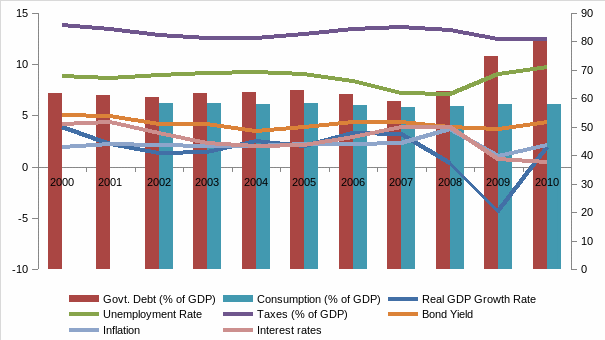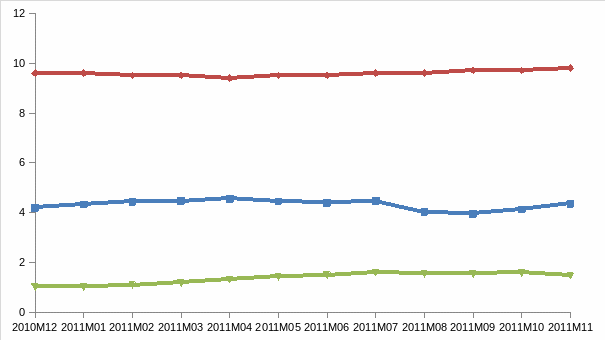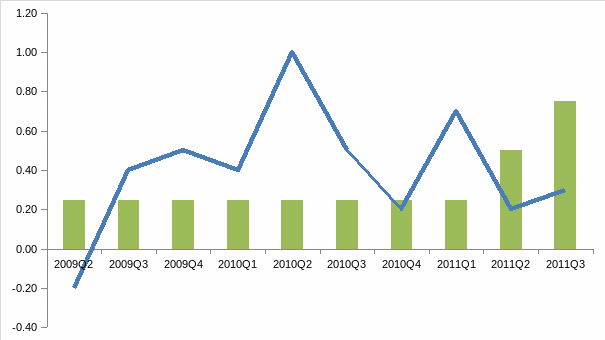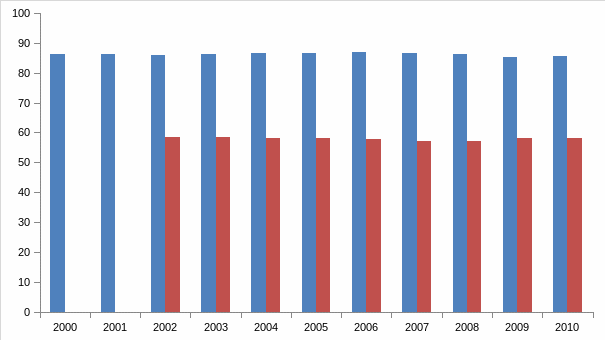Introduction
The Euro is expected to fall in the coming year. Speculations are that the EU will not be able to retain its common ground and, therefore, will lead to the fall of the EU economies. This is discussed in the article published in The Economist on 26 November 2011 (Economist, 2011). The article discussed for macroeconomic analysis is based on the recent speculation on the prospect and future of Euro that arose due to the increasing debt burden of some of the European Union countries. The article provides a detailed understanding of the impact the fall of Euro will have on the economies and the reasons why such a future is expected to arise. This paper first discusses the article in detail and then presents an analysis of the issues discussed from economic perspective. Then it attempts to provide a possible solution to the problem derived from the analysis.
The Article
The article in The Economist discusses the increasing pressure on the eurozone countries of the increasing debt burden that is leading to monetary tightening, lower investor and consumer confidence, and subsequently lower growth. The article discusses the surging pressure of Euro as many of the countries like Greece and Italy have to be bailed out of their public debts. The currency index for Euro has gone down to 47.2, which is considered bad when below 50. The German bonds failed to be sold in auction this year, and the bond yield for some countries like Spain and Italy has gone up to 7% mark. The article presents the apprehension of the eurozone getting into a recession due to the following reasons “credit crunch, tighter fiscal policy, and a dearth of confidence” (Economist, 2011).
However, the Euro’s exchange rate has not declined, and the reason is in the consolidated Euro fund, but the households and the private sector will soon be affected due to the paucity of credit and increasing interest rates. Due to the weakening of the financial position, governments, like that of France, Spain, and Italy, are aiming at budgetary cuts and austerity. This is expected to reduce growth in the economy, and overall it is expected that the growth rate will be down by 1 percent in 2012 (Economist, 2011). This, again, will reduce investor’s confidence and consumer confidence. Therefore, a fall in demand for industrial goods and consumers durable like automobiles will affect the manufacturing industry and will, therefore, affect the growth of the economy.
A declining growth will, therefore, affect the internal functioning of the economy, thereby increasing unemployment, due to which tax receipts will decline. This, in turn, will increase deficits for governments. The reason for the woes of the EU countries, especially the like of Greece, Spain, and Portugal is its high amount of debt to foreign investors. The problem arose when the private banks received a lot of cheap foreign finance but were unable to pay back to their investors. This led the governments to pay for their debts, and in the process, buying those private debts, which the government too was not in a position to pay back. This led to the large debt burden on the economy. The next section will analyze the article using macroeconomic tools.
Analysis
The article presents three adverse economic indicators that are causing alarm to the analysts:
- Increasing bond yield.
- Falling demand for industrial goods.
- Increasing interest rates.
- Increasing unemployment.
- Declining growth rate of GDP.
- Declining tax receipts.
These indicators presented in the article show that the economy of the EU is facing a serious macroeconomic problem. This section of the paper will discuss how intense is the problem in the EU from the details presented in the article.
Figure 1 shows that shows the indicators referred in the article and their change from 2000 through 2010 (Eurostat, 2011; Eurostat, 2011; ECB, 2011). The main problem that has been referenced in the article is the increasing price of bond yield and the increasing government debt. Government debt is the amount of money that the governments owe to private or foreign financial institutions. This shows that the government debt of EU has been increasing constantly since 2007. In 2010, it increased to 80.1%.

Government Debt
Increasing debt of the government created pressure on the economies. As countries like Greece failed to give back their loans to foreign financial institutions, EU loaned Greece to pay back its debts. However, this created a negative sentiment for EU in the international financial market. Financial institutions had become averse to lending out money to EU countries specially Greece, Spain, Italy, and Portugal. Therefore, bonds that are sold by governments to gather finances to meet their developmental and general expenses lost their credential in the international market. The reason was lowering of confidence in the EU economy among foreign investors. Therefore, demand for bonds declined in the international market. For instance, the article states that even Germany, which still posts strong economic fundamental, failed to sell its bonds in auction. Clearly, demand for EU bonds in international market reduced as confidence on the EU economy declined. Reduced demand for bonds led to increase in bond yield. Bond yield is actually the cost of bond to a country.
Bond Yield
Bond yield is actually the interest paid by the government for the loan that it gets through selling of bonds to the investors. Therefore, as bonds’ demand reduces, the cost incurred to the governments to sell bonds, i.e. bond yield increases. Figure 1 shows that the bond yield in the EU has been increasing since 2008. A monthly analysis of the bond yields in 2011 shows that the bond yield increases initially of 2011 (Eurostat, 2011). Figure 2 shows that there is an increase in bond yield for the last one year in the EU area has been increasing. Therefore, increasing bond yield shows that the cost to sell bonds for countries in EU has been increasing constantly. Very high Bond yield for other EU countries other than Germany, which is below 4%, while that in other EU countries average to close to 6%. Banks are selling off government bonds to increase cash flow. The increase in the supply of bond in the market led to the decline in its price, which led to fall in demand. The increase in bond yield created credit crunch, as there were no takers of bonds of these economies. Therefore, the decrease in credit availability in the economy leads to decline in consumer demand and lack of availability in loans, led to the decline in investment.

Interest Rate
Figure 2 shows that, as there is an increase in the bond yield of the EU, there was an increase in the unemployment rate. Interest rates, on the other hand, started declining. As investment declines, there is a decline in the demand for consumer durable goods. As goods demand declines due to lack of investment in the economy there was a fall in the growth of the economy. Figure 3 shows that there was a decline in the quarterly GDP growth of the economy. Initially the central bank interest rates declined due to the monetary policy of the central bank to increase liquidity in the market. However, this led to further credit crunch, and therefore, interest rates was increased further.

Unemployment Rate
The effect of the decline in GDP growth led to the decline in production and therefore, less income in the economy. In 2009 there, real GDP growth became negative. As there was less income and investment in production there was an increase in unemployment rate of the economy since 2007. Increased unemployment rate led to the decline in the income, which in turn affected the government receipt of revenues through tax receipt.
Tax Rate
There has been an increase in the decline in tax rate. As there has been a decline in investment and therefore production, this led to the decline in income. Figure 4 shows that there is a decline in NNI as a percentage of GDP has been decreasing since 2007. Further, there is a decline in the consumption leading to a decline in demand for consumer durable goods. As there was less money in the economy, there was a decline in the tax receipt which led to a decline in the tax rate.

Conclusion
The increase in the bond yield is an indicator of the weakening of the financial and money market of EU. As there is a weakening of the monetary market, there is a decline in GDP growth and therefore there was a decline in the employment, increasing unemployment rate. Employment fell due to the cringing of the investment leading to reduction of production. Increase in unemployment rate would lead to decline in consumer expenditure therefore further shrinking the economy. the outcome of the present economic condition of the EU is expected to be worsening of the EU economy. due to the high bond yield, declining interest rates, and decline in the money supply in the economy, there is expected to be a greater credit crunch. Lack of liquidity in the market would lead to a decline in production in the economy. A the article indicates, there is already a decline in the investment in the industrial sector. Credit crunch would also decline in the demand for consumer durables like automobiles, which in turn would reduce production. Decline in production would reduce GDP. If this situation continued, this would also lead to a decline in the Euro’s exchange rate, which so far had been holding stable due to the EU consolidated fund. However, with declining investor confidence in EU, this too would start declining leading to the dissipation of the joint currency.
References
ECB. (2011). Statistics. Web.
Economist. (2011). Beware of falling masonry. Web.
Eurostat. (2011). Eurostat. Web.
Eurostat. (2011). Selected Principal European Economic Indicators. Web.